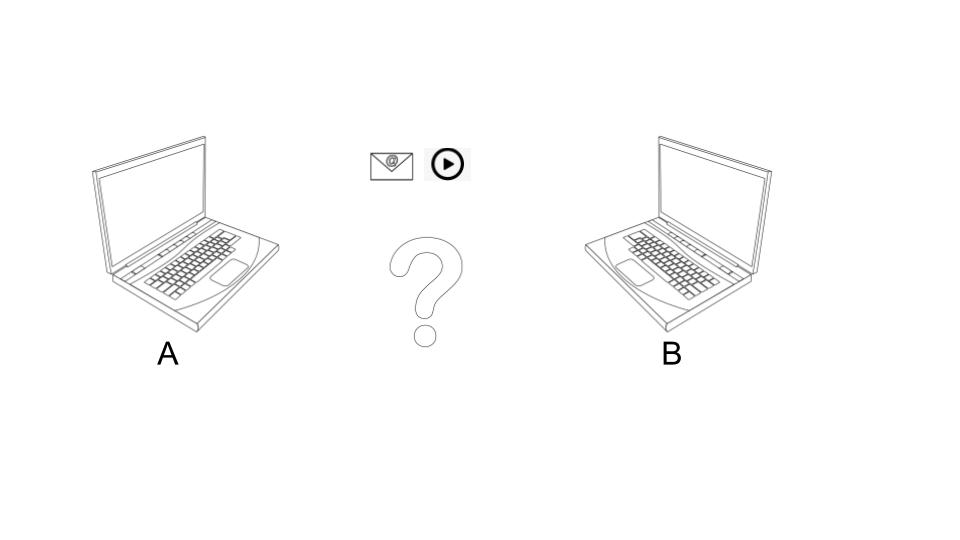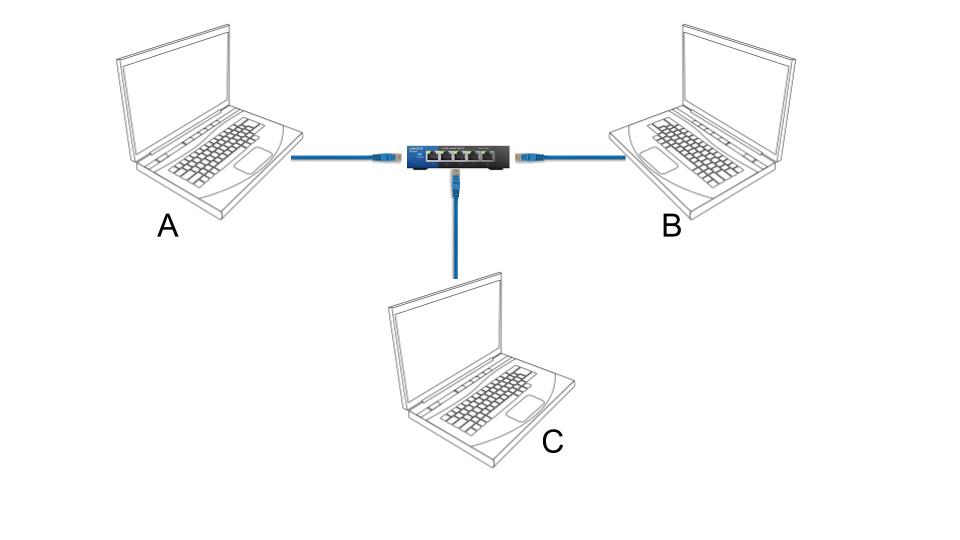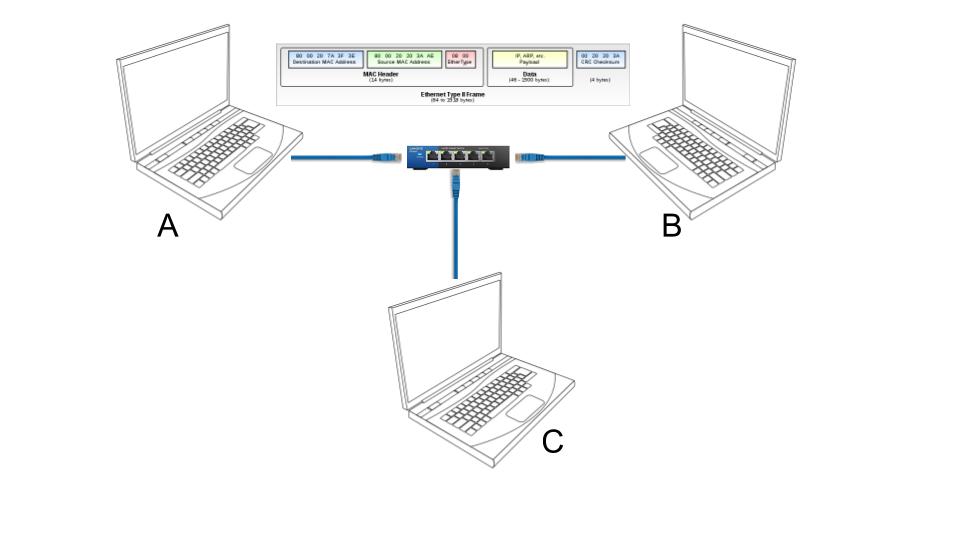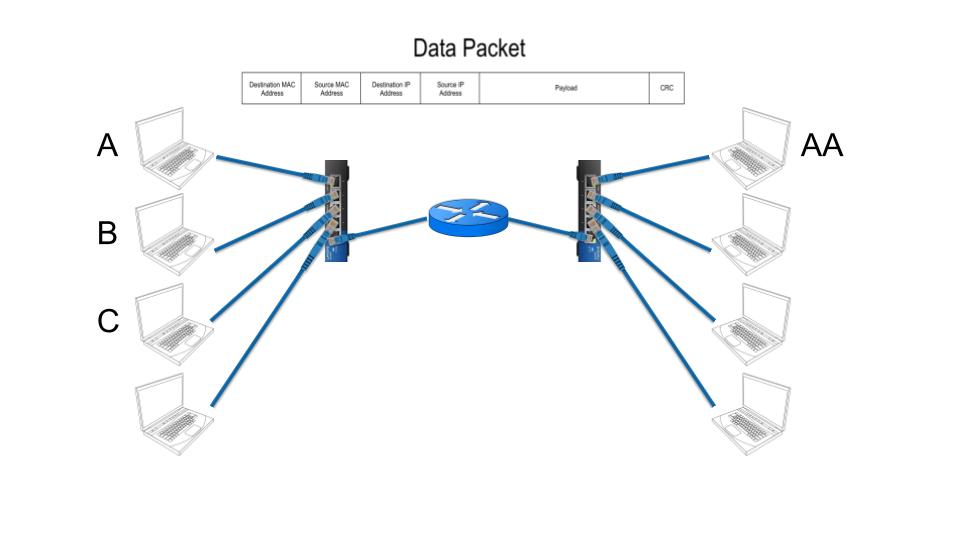Computer Networking 101
09 Mar 2019- Two Machines
- More Machines - MAC Addresses
- Networks, Routers and IP Addresses
- ARP, broadcast
- More Networks - The Internet
Two Machines
Let’s start from the simplest case. I have two machines. How do I make them communicate with one another? By communicate, I mean, sending a text message, an email, an image, or a video from one to the other.

Throughout the history of computer networking there has been multiple ways to achieve this, but in this post I focus on the modern, industry standard way. The bare minimum I need are: two Ethernet cables, one for each computer, and a Ethernet switch. The switch needs at least two ports, and an end of the each Ethernet cable needs to be plugged in to one of these ports.

A text message is represented by the operating system of machine A as a sequence of ASCII codes, each of which is four bytes. A byte is eight bits, with a value of either 0 or 1. A bit, after everything, is what the operating system uses to talk to hardware components, whether it’s saving to memory, disk, or transmitting over network. An email is a structured text, which fundamentally are ASCII codes. An image, is a matrix of tuples, each tuple being represented by three numbers. Numbers, as ASCII letters, are transmitted as bits. A video, after some even more complex decoding, is essentially a sequence of bits as well.
To transmit a bit out, the operating system puts the bit to a buffer of the Network Interface Card (aka NIC, in our case, the Ethernet card on machine A). The NIC generates a electric vibration, which is carried over by the Ethernet cable to the port it connects to of the switch. The switch, a simple integrated circuit board, gets that vibration and relays it to the other port, which machine B connects to. Through that other Ethernet cable, machine B’s NIC receives the vibration, and tells the operating system that a bit of a certain value has been received. Of course this is an overly simplified version of what’s really happening (for example the NIC ususally sends more than one bit at a time, rather it sends a packet or a frame), but it is the principle of how things are transmitted at the physical layer.
More Machines - MAC Addresses
You may have noticed that a switch typically has 5 or more ports. Some enterprise switches may have 20+ ports. In fact, often times more than two machines are connected to the same switch. Let’s assume we add machine C to mix. How would that change the way machine A sends a packet to machine B?

Machine A’s NIC still generates a sequence of vibrations which are carried over to the switch. When the switch gets the vibrations (the packet) though, how can it be sure to rely them to the port where machine B is connected and not the port machine C is connected? If switch was replaced by a Ethernet Hub, the hub would have sent the packet to ALL connected ports. This is called packet repeating or broadcast. This can be very inefficient, insecure, and causes unnecessary congestion in the hub. A switch, on the other hand, has a smart trick to make sure packets are relayed to and only to the right port. The trick is called MAC addressing.
Each NIC connected to the same switch has a unique MAC address. It is a 48-bit number. While in reality MAC addresses can be updated using software by a system administrator, for the purpose of this post we will assume that NIC manufactures take the right cautions to make sure each NIC gets a universally unique MAC address. When a NIC is connected to a port of a switch, the switch learns its MAC address. When machine A wants to send a packet to machine B, it includes machine B’s NIC’s MAC address in the packet’s header, as the packet’s destination. When the switch sees such a packet, it recognises the destination address, and relays to the port that machine B is connected to. In the same way, machine A, B and C, can send packets to one another and the switch will be the reliable mail man that makes sure they are delivered correctly.

Networks, Routers and IP Addresses
The three machines have formed a small network, in the sense that any one in the network could talk to any other one. If I get two more computers, I can plug them into the same switch and I will have a network of five hosts. Now, if I get another machine, or two more machines, how can I add them to the network? I don’t have a spare port on the switch any more. Apparently I am going to need another switch, which can connect five more machines. Let’s assume I now have two fully occupied switches and ten machines like the following, how could machine A on switch 1 speak to machine AA on switch 2? Since machine AA is not connected to switch 1, when switch 1 gets the packet from machine A it doesn’t know where to send it to. The reserve direction is true too.
[Image of two switches, with a question mark between them]
Sounds like we need something in between them that is willing to forward packets from one end to the other. And such thing exists as routers. A router is a device that has two or more NICs, and forwards packets from one to another according to its routing table. Now let’s add a router with two NICs to the diagram. One of its NIC connects to a spare port of switch 1, the other connects to switch 2. To switch 1 and 2, the two NICs are no different than the other NICs which belong to machines.

With this setup, machine A needs to make some change in the way it sends packets out too. Though it still wants to send a packet to machine AA, it puts the router’s NIC1’s MAC address in its packet to switch 1. Seeing that, switch 1 relays it to the router’s NIC1. Getting that, the router looks at its routing table, and forwards the packet out through its NIC2, which is connected to switch 2. Before forwarding the packet though, the router replaces the destination MAC address with the MAC address of machine AA so that when switch 2 gets the packet it will relays it to machine AA. This is how machines behind two switches communicate with each other - through a router!
IP address. There are some important details we left out in the previous example. For example, how does machine A know to put the router’s MAC address as destination? When the router gets the packet the there is nothing that says about machine AA, how does it know it’s targeted for AA? Sounds like we need some more metadata in the packet. And that is IP address. In fact, IP addresses (and IP address ranges) are the key used in a routing table.
First all, every machine on a network is configured with its router’s IP address. Every machine also has its own routing table. After some complex network probing process that we will leave out deliberately for keeping this post brief and focused, machine A understands, from its routing table, that to reach machine AA’s IP, it needs to send the packet to the router. In the packet it sends out, it will set the destination MAC address as the router’s NIC1’s, but the destination IP address as machine AA’s. When the router gets the packet, it recognizes that IP address, looks it up in its routing table, and finds the MAC address of machine AA. This is possible because the router is also connected to switch 2. It replaces the destination MAC address with machine AA’s, sends it off to switch 2, which subsequently relays it to machine AA.

Now we can see how an IP address in addition to a MAC address is necessary in a network packet. An IP address based communication crosses the boundary of a switch.